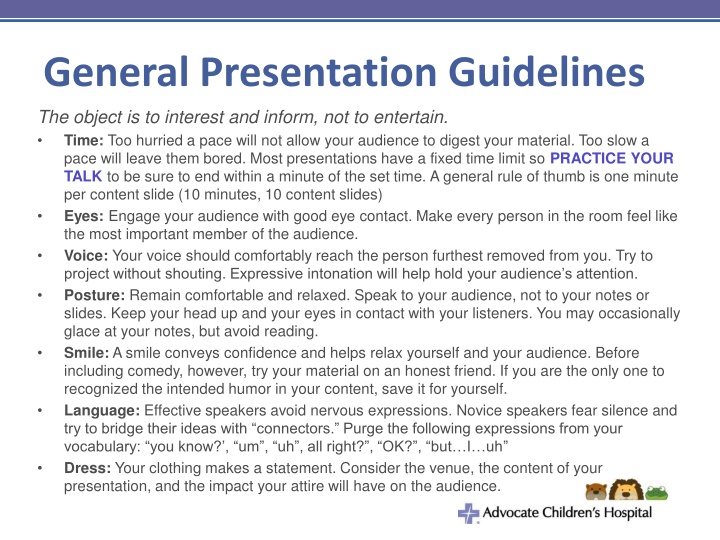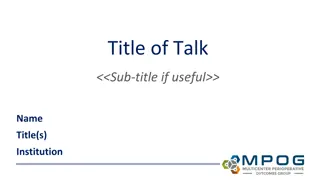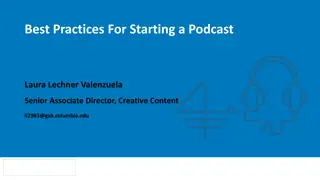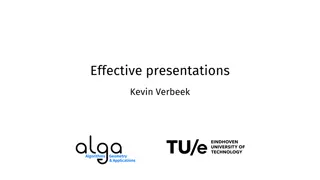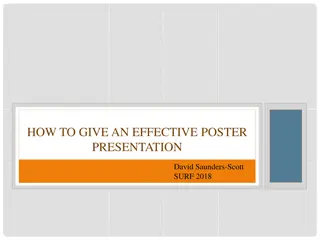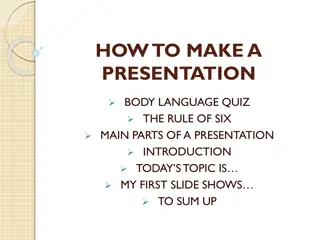Effective Presentation Guidelines for Engaging Audience
Presentations should aim to interest and inform the audience, maintaining a pace that allows for comprehension without boredom. Tips include engaging eye contact, clear voice projection, comfortable posture, and avoiding nervous expressions. Dress appropriately and smile to convey confidence. The content should include sections on Introduction, Background/Literature Review, Objectives, and Case Description. Practicing and following these guidelines will help in delivering a successful presentation.
Download Presentation

Please find below an Image/Link to download the presentation.
The content on the website is provided AS IS for your information and personal use only. It may not be sold, licensed, or shared on other websites without obtaining consent from the author.If you encounter any issues during the download, it is possible that the publisher has removed the file from their server.
You are allowed to download the files provided on this website for personal or commercial use, subject to the condition that they are used lawfully. All files are the property of their respective owners.
The content on the website is provided AS IS for your information and personal use only. It may not be sold, licensed, or shared on other websites without obtaining consent from the author.
E N D
Presentation Transcript
General Presentation Guidelines The object is to interest and inform, not to entertain. Time: Too hurried a pace will not allow your audience to digest your material. Too slow a pace will leave them bored. Most presentations have a fixed time limit so PRACTICE YOUR TALK to be sure to end within a minute of the set time. A general rule of thumb is one minute per content slide (10 minutes, 10 content slides) Eyes: Engage your audience with good eye contact. Make every person in the room feel like the most important member of the audience. Voice: Your voice should comfortably reach the person furthest removed from you. Try to project without shouting. Expressive intonation will help hold your audience s attention. Posture: Remain comfortable and relaxed. Speak to your audience, not to your notes or slides. Keep your head up and your eyes in contact with your listeners. You may occasionally glace at your notes, but avoid reading. Smile: A smile conveys confidence and helps relax yourself and your audience. Before including comedy, however, try your material on an honest friend. If you are the only one to recognized the intended humor in your content, save it for yourself. Language: Effective speakers avoid nervous expressions. Novice speakers fear silence and try to bridge their ideas with connectors. Purge the following expressions from your vocabulary: you know? , um , uh , all right? , OK? , but I uh Dress: Your clothing makes a statement. Consider the venue, the content of your presentation, and the impact your attire will have on the audience.
Title of Project Author(s) Names (Identify faculty mentor, if applicable)
Introduction In this section you want to inform your audience of all the relevant background information of your project Each bullet point should be a concise summary of what you will tell the audience verbally Written text of your verbal presentation belongs on notes pages reserved for your personal use during the presentation
Background/Literature Review This section should include background information about your case. Highlight the unique aspect of the case or the novel insight into pathophysiology, diagnosis or treatment. Provide a brief literature review for your audience, if applicable.
Background/Literature Review Insert additional slides for background/literature review as needed be cognizant of your time limit.
Objective(s) The objective should be included directly after the introduction. Be specific and clear about the purpose of using a case study approach to introduce the topic.
Case Description The case description should include the pertinent information about this case. Be consistent with your objective and methods. Patient presentation/examination Pertinent labs and images Consider whether you should include family history, social history
Case Description Insert additional slides as needed to provide a thorough description. Be cognizant of your time limit.
Tables and Figures Make sure that your data is not too complex for a single graph. Often, you can split one chart into two to make the point more clearly. Label your graphs clearly and consistently; include axis titles and legends Choose the right chart type for your data (ie. Bar chart, Pie chart, etc.) It s often useful to add an arrow or callout to the chart to point out important data or trends When presenting graphic information start by describing which variable is displayed on each axis and its unit and the legend
Discussion Conclusion section highlight the take-home point brought up by the case. Do not repeat the same information from the case description section, instead create summary statements. Include information from the literature that compares to the interesting or unique aspects of the case. Point out any social or ethical considerations unique to your patient and the involvement of multidisciplinary team members. Include limitations and recommendations for future research needs.
Conclusions Can you draw any conclusions from this case? Include suggestions for applications
Acknowledgements Acknowledge those study team members and hospital associates, including your mentor, residents, fellows, nurses, and/or office staff who provided ancillary or intermittent assistance but who did not make a direct and significant contribution to the study. Include funding sources using complete and formal titles.
References Include proper references for those citations included in the presentation.
